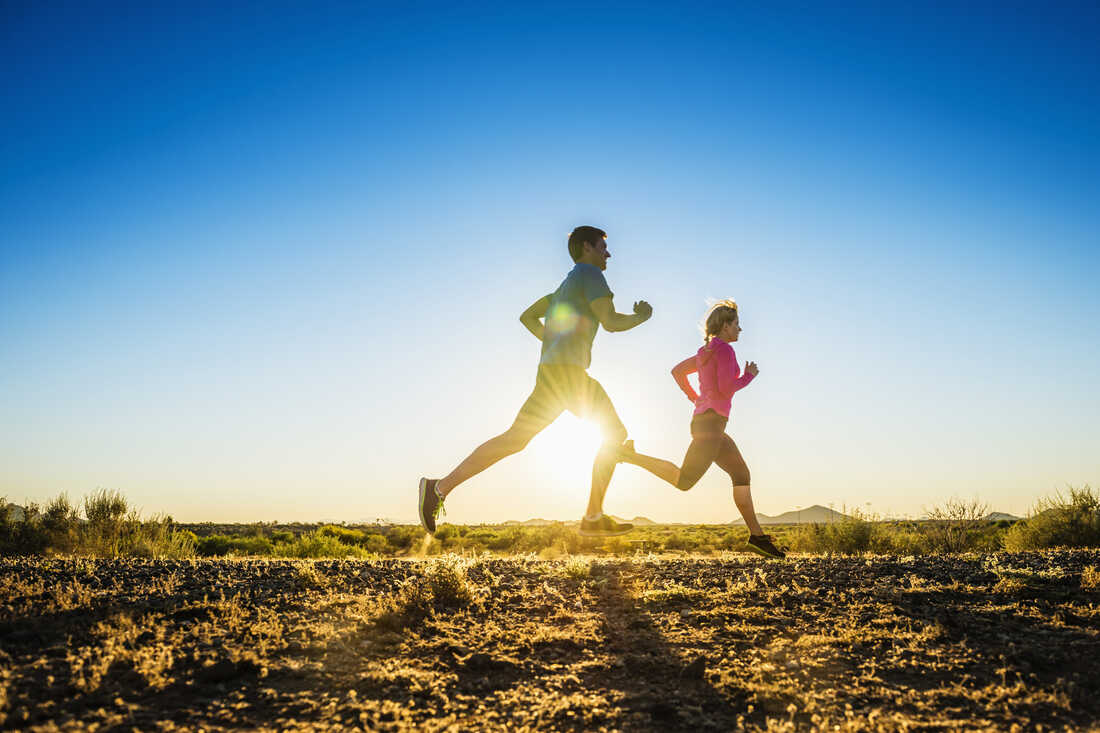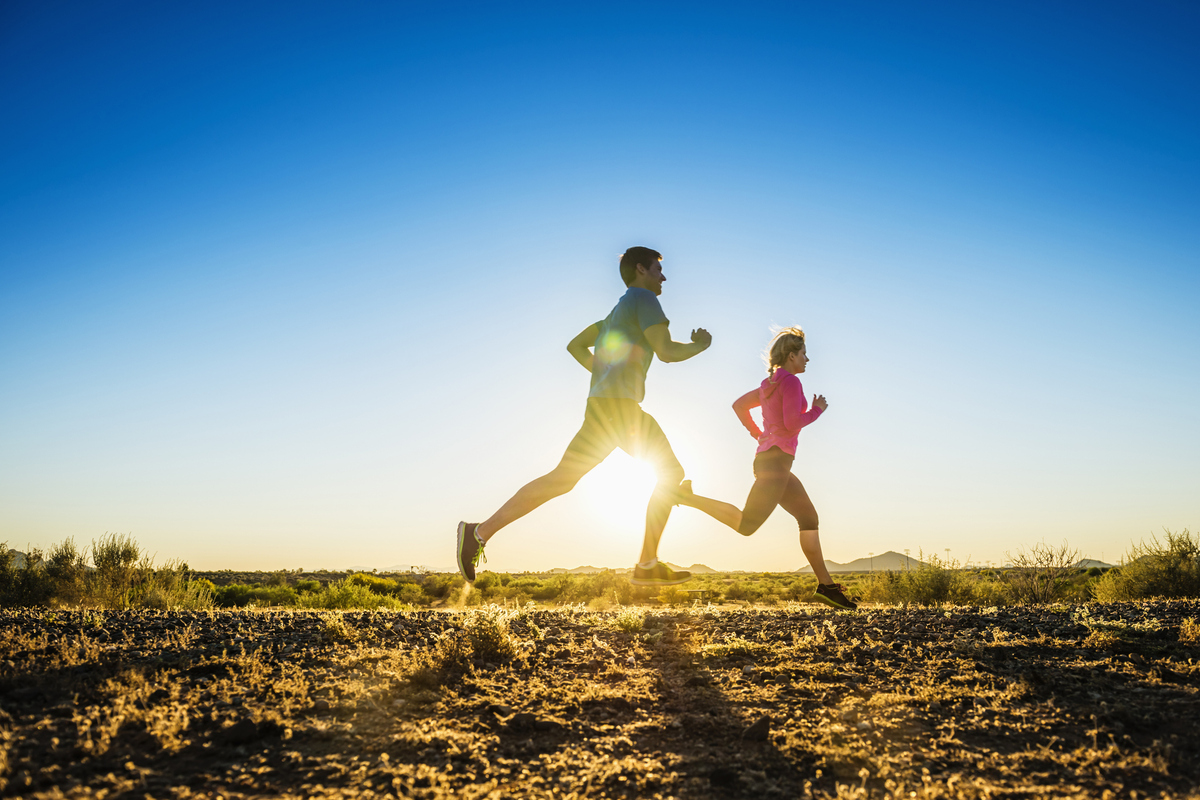
What’s the best time to exercise? The science of circadian rhythms has some clues.
Jacobs Stock Photography Ltd/Getty Images
hide caption
toggle caption
Jacobs Stock Photography Ltd/Getty Images

What’s the best time to exercise? The science of circadian rhythms has some clues.
Jacobs Stock Photography Ltd/Getty Images
For years, I was an inveterate early morning exerciser — the kind of person you’d spot trudging into the gym just after the doors were unlocked or running through the neighborhood when the coffee shops were still silent.
But this dedication fell precipitously as the day progressed. In fact, any workout that deviated from my regular routine would feel almost excruciating.
Karyn Esser recalls a similar experience when she tried to run in the afternoon instead of the morning during graduate school.
“I could do it, but it always felt like something wasn’t right,” says Esser, now chair of physiology and aging at the University of Florida’s College of Medicine.
So when is the best time to exercise? In truth, there is no scientific consensus. The question gets surprisingly thorny as you drill down into the specifics. Who’s exercising? What exactly are they doing? What are their goals?
Still, the last decade has brought a wave of new research on the interplay between exercise timing and circadian rhythms — the patterns in our physiology and behavior that fluctuate over the 24-hour cycle. These advances have led to new insights about how the timing of your workouts can affect both health and athletic performance.
“There’s a great deal of our physiology that’s under this molecular clock,” says Juleen Zierath, a professor of physiology at the Karolinska Institute in Sweden. “What we’re trying to understand is how can you fine-tune the exercise prescription.”
Here are four findings from the latest science.
1. Exercise can help keep your body’s circadian rhythms in sync
If you’ve ever had jet lag, you’ve experienced the quintessential example of your biological clocks being out of sync — what scientists call circadian misalignment.
It’s not just travel that can throw us off, though.
All kinds of behaviors — like staying up too late on the weekend or eating at unusual times — can cause circadian disruption. This can feel crummy and can have far-reaching consequences for our health, depending on how long it lasts.
Circadian rhythms involve more than just the central clock in the brain, because every organ and tissue has its own molecular timekeepers, what scientists call peripheral clocks.
“Under normal conditions, our clocks are aligned — they’re in the same time zone,” explains Esser. “Problems arise when our clocks are misaligned, so the brain clock thinks it’s here, and the liver and the pancreas think it’s something else.”
Light is the most potent external time cue, technically known as a zeitgeber, that aligns circadian rhythms with the outside world. This is what the brain clock likes to follow, and that ultimately influences all kinds of biological processes and behaviors, most notably when we wake up and go to bed.
Though not as powerful as light, exercise can also be a strong signal for our circadian system, most of all for the peripheral clocks.
This means physical activity can be another tool to help get your body synchronized and lined up with its sleep-wake cycle.
Studying exactly how this plays out in the real world is tricky though, because our bodies are constantly hearing from other zeitgebers like light and food. While results aren’t entirely consistent, recent clinical trials have found that exercising in the morning or early afternoon can push your rhythms toward an earlier schedule.
On the other hand, evening physical activity seems to delay the clock, although this may not be true for those with later chronotypes — i.e., night owls.
2. Your muscles follow their clocks, and timing effects performance
Scientists have learned the clocks in our cells are intertwined with the important business of that particular tissue or organ.
“Every cell in our body has a circadian clock,” says Katja Lamia, an associate professor of molecular and cell biology at Scripps Research. “That means so many aspects of our physiology are different — at different times of day.”
For example, the clocks in our pancreas are involved in the production of insulin, which changes over the course of the day, while those in the liver are regulating blood glucose or how you metabolize certain drugs, she says.
Then there are the muscle clocks.
Esser, who has pioneered research in this area, says muscle clocks are key in guiding when the cell takes a break to rest and repair, including storing up energy, and when to get primed for activity.
“The clocks are really part of homeostasis and taking care of business in the cell,” she says.
Consequently, these timekeepers are closely tied into our metabolism and how we use energy, given that muscles have a big role in handling glucose, among other things.
Scientists have found that the clocks are involved in pathways that use sugar for energy and in transporting that glucose from outside the cell to inside.
The efficiency of your mitochondria — the power plants of the cell — also changes throughout the 24-hour cycle, with research showing a peak during the late afternoon.
And these fluctuations in our muscles may affect performance.
Their exact contribution isn’t entirely clear, but it might partially explain a long-standing finding — that people tend to lift the most weight, run the fastest and break the most world records later in the day.
This trend is “incredibly consistent,” says Esser.
Raphael Knaier, an exercise physiologist at the University of Basel in Switzerland, who reviewed this evidence, says, yes, the afternoon does come out on top — but it’s still hard to generalize because this research comes mostly from younger males and the quality isn’t great.
“Just because the afternoon is the best time, on average, over a certain population does not mean that it’s the best time for every individual,” he says.
Scientists have speculated that everything from shifts in core body temperature to hormones to neural activation could be responsible for this morning-to-afternoon variation.
The muscle clocks are another possible explanation.
“The evidence is very suggestive that circadian clocks in the muscle and probably in other organs are important for driving these differences in exercise capabilities,” says Lamia. “It just hasn’t been proven yet.”
3. You may be able to shift your muscles’ circadian rhythm to your preferred workout time
In recent years, scientists like Esser have found that muscle clocks can get on their own schedule. In fact, they are exquisitely responsive to exercise.
Lab experiments on human muscle cells have revealed that just delivering electric shock to mimic exercise so that “they twitch and generate force is sufficient to change the clock settings,” says Esser. Animal studies show that exercise can actually override the influence of the brain clock.
Despite the data favoring afternoons, there’s some tantalizing albeit preliminary research from Esser’s lab suggesting that exercising regularly in the morning can train your muscles’ clocks to perform just as well at that time of day.
The study found that mice that ran during the early part of their active phase — the equivalent of the morning for humans, since mice are nocturnal — started off with a lower endurance level than the group running in what would be our afternoon.
However, after about three to six weeks of daily treadmill work at the same time, the “morning” runners did just as well as the afternoon ones.
When they analyzed the muscle tissue, Esser says, they found the muscle clocks had shifted about four hours earlier in the early group.
The implications?
“The phase of the clock is trainable,” and that can be shifted to potentially maximize your performance, she says.
The study is yet to be published and has limitations — it would be hard to pull off the same carefully controlled and invasive experiment in humans. But the idea that consistency matters is echoed in the human data, as well.
“There’s pretty good evidence that if you exercise regularly at the same time of day, then you tend to improve your performance the most at that time,” says Lamia. This is why athletes like to train for the time when they plan to compete.
4. Exercise timing could hold secrets for our health
Even if you’re not obsessed with beating the competition, Esser says that in the long run, it’s probably still helpful to exercise at about the same time — for the sake of keeping your biological clocks in tune.
“It doesn’t have to be exact, because clocks are not precision,” she says, “You’ve got a two-, three-, potentially four-hour window.”
Scientists are also trying to pinpoint a specific time of day that could unlock added benefits for those with medical conditions.
Circadian misalignment is associated with many health conditions, including cancer, diabetes, cardiovascular disease and psychiatric illness. It’s believed to contribute to why night-shift workers are at increased risk for all kinds of ailments.
“If we can learn how to synchronize the circadian system better, we could potentially prevent some of those health issues or help ameliorate them,” says Shawn Youngstedt, a chronobiologist at Arizona State University.
The latest frontier in this research focuses on metabolic syndrome or diabetes.
There’s compelling evidence that circadian disruption can wreak havoc on blood sugar and insulin. This is even seen in healthy people whose clocks get out of sync for a relatively brief period of time. A handful of recent studies make a case for afternoon exercise in those with Type 2 diabetes and metabolic impairments.
“We’re trying to use exercise to basically reset the rhythms” of the muscles’ clocks and, in doing so, “reset their metabolism,” says Zierath, of the Karolinska Institute.
A mouse study from Zierath’s team has shown that exercising in what would equal late morning for humans could be more effective at boosting metabolism and burning fat.
A study of men with Type 2 diabetes, also done by Zierath, found that high-intensity training in the afternoon improves blood sugar, whereas the morning actually led to a worsening of it.
Other research also supports later-in-the-day exercise for helping people with metabolic impairments, but Zierath emphasizes that this isn’t “settled science yet” because there are so many variables.
“Was this because we only studied men with diabetes? We also want to see what happens with people with normal glucose tolerance,” she says.
Indeed, these results are not seen across the board, with other studies actually finding that the morning can be better for patients with metabolic syndrome. In healthy people, it may be that evening exercise helps blood pressure in men, but morning is better for women.
“In general, we’re still at a pretty early stage of trying to understand this,” says Lamia, of Scripps Research.
She says one thing is absolutely clear: “I think the best time to exercise is whenever you’re actually going to do it.”




